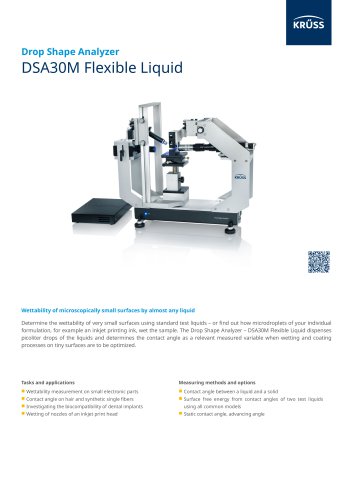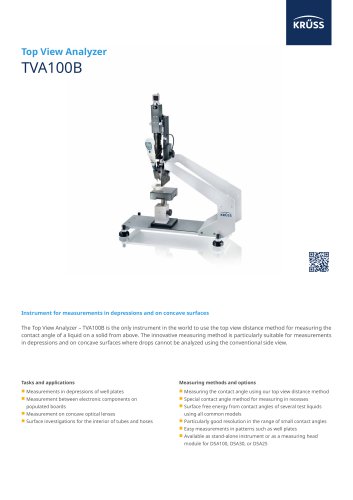 Website:
KRÜSS GmbH
Website:
KRÜSS GmbH
Group: Krüss
Catalog excerpts

Technical Note Practical Contact Angle Measurement (3) Technical note: Industry section: Drop Shape Analyzer – DSA100 Method: Keywords: methods, contact angle, sessile drop The eye also measures The optical system with illumination, camera and video image evaluation is the heart of a contact angle measuring instrument. Its increasing precision is primarily due to advances in video technology and drop shape analysis. This third part of our series on practical contact angle measurement helps you to utilize the possibilities of the optics to the full and measure accurately and reproducibly. In comparison to dosing, in which the volume and volume flow together with the dosing procedure can be exactly controlled, setting the optical parameters is apparently concerned with more subjective criteria: The drop image should be “well” illuminated and “sharp” and “as large as possible”. In fact the optical parameters can also be controlled exactly and matched to suit the measuring task. Preparations The creation of optimal optical conditions starts with the selection of the measuring location. External light influences negatively affect the shadow image of the drop created by using the instrument illumination. The result is a broader gray level distribution of the drop shape and the surrounding white region; this affects the accuracy of contour recognition. In extreme cases – for example direct sunlight – light reflexes can result in the drop not being recognized at all. The objective or prism and the glass panel in front of the light source should not be touched with the fingers and never with sharp-edged objects. If marks are seen on optical components these should be carefully removed using a solvent-impregnated (e.g. isopropanol), lint-free cotton swab. All adjustable optical components should have been adjusted before the dosing process; afterwards only minor corrections at the most should be made so that as little time as possible elapses between the drop contacting the sample and the measurement itself. Otherwise incorrect results could be obtained, for example as a result of evaporation of the liquid. KRÜSS GmbH | Borsteler Chaussee 85 | 22453 Hamburg | Germany | www
Open the catalog to page 1
Illumination “Bright lights cast dark shadows” – this saying only has a limited validity for drop shapes, as the drop liquid is normally light-permeable, so that a bright illumination increases the gray levels not only outside but also inside the drop and possibly produces an unfavorably broad gray level distribution. In addition, if the illumination is too bright then diffraction effects can make the shape appear smaller – the drop is “over-illuminated”. When you have gained some experience in measuring contact angles you will realize that a drop image that is optimal for evaluation...
Open the catalog to page 2
With non-reflecting samples a max. 4° observation angle can be set for easier recognition of the baseline. At this angle the distortion of the shape is so small that it hardly affects the measured value; the transition between the drop shape and the sample is much clearer. The DSA100 is equipped with specially constructed prism optics allowing the inclination angle to be adjusted. If the video system uses a frame-grabber then the contrast can be additionally increased by using the software; this also makes it easier to recognize the border region. Fig. 3: Drop with baseline In principle the...
Open the catalog to page 3All KRÜSS GmbH catalogs and technical brochures
-
DSA30M Flexible Liquid
2 Pages
-
Tensíío
2 Pages
-
Ayríís
2 Pages
-
FORCE TENSIOMETER – K20
2 Pages
-
FORCE TENSIOMETER – K6
1 Pages
-
TOP VIEW ANALYZER – TVA100B
2 Pages
-
DROP SHAPE ANALYZER – DSA30
2 Pages
-
DROP SHAPE ANALYZER – DSA30M
2 Pages
-
DROP SHAPE ANALYZER – DSA30R
2 Pages
-
Drop Shape Analyzer DSA25
2 Pages
-
DROP SHAPE ANALYZER – DSA100
2 Pages
-
Dynamic Foam Analyzer DFA100
2 Pages
-
Product Overview 2023
86 Pages
-
BPT Mobile – Data Sheet
4 Pages
-
DSA100, DSA30, EasyDrop
5 Pages
-
DSA100, DSA30
4 Pages
-
DSA100
3 Pages

































